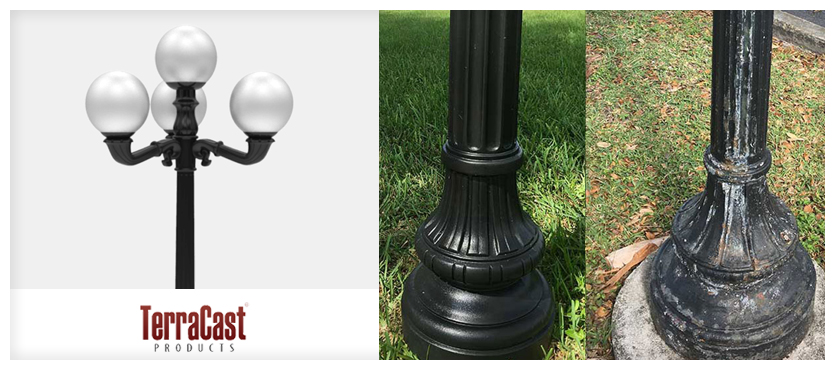Light poles provide essential functions to cities and communities by providing light for commuters, workers, and pedestrians. While all light poles are made to last and survive the rigors of an urban environment, traditional metal-made light poles remain prone to damage from vehicles, weather elements, landscaping equipment, and much more.
All things considered, the costs for repair and maintenance will only add up over time which is why you should consider using resin over traditional materials like aluminum to build and house light poles. Here are five common problems light poles have to deal with in most urban environments and how resin can offer a solution to minimizing those issues.
Rust and Corrosion
Typically, a traditional metal light pole has a layer of baked enamel or powder coat that will show scapes, cuts, and cracks from natural wear over its lifetime. While this may not appear a big deal, they are an entry point for rust and corrosion to develop and degrade the metal over time until it is no longer tenable and requires repair or replacement. This is where resin can be advantageous. Unlike metal, resin is not vulnerable to rust or corrosion, making it a more durable long-term solution than traditional metal materials used in building light poles.
Environmental Damage
With light poles positioned in busy urban areas, the likelihood of damage from vehicles, pedestrians, or landscaping equipment is high. Furthermore, weather elements, salt from nearby ocean air, or even dog urine will inevitably wear down the exterior coating of a light pole over time, making its base vulnerable to corrosion damage. That is why resin is a better alternative to metal. Resin features the durability of metal in withstanding impact or physical damage without having any of its vulnerabilities to weather elements and corrosion.
Vandalism
Another common problem in many cities is graffiti vandalism, something metal light poles are vulnerable to as well. Graffiti can negatively impact the visual aesthetic of an area, making what should be a clean-looking area look dirty and unkempt. That is where resin can offer a solution. Resin is a non-porous material, making it incredibly resistant to most types of paint and easy to clean in the aftermath of graffiti vandalism.
Maintenance Costs Over Time
One thing to keep in mind with metal light poles is the natural wear and tear that occurs over time. Even if a metal light pole can remain unharmed from any physical damage or corrosion from the weather and environment, it is still likely to experience some chipping and peeling over time.
The cost of routine paint jobs to keep them in good shape adds up in the long run, which is why you should consider light poles that use resin instead. Unlike metal, resin does not experience any chipping or peeling, which means you will not have to give it a paint job to restore its appearance, thereby reducing maintenance costs over its lifetime.
Shipping Costs and Installation
Metal light poles are heavy, making them expensive to transport and more difficult to install. By contrast, resin is lightweight, making it more cost-effective to ship and easier to install. Resin light pole bases, for example, can easily be handled by one or two people without the need for heavy equipment, unlike metal bases. To reduce your initial investment and overhead costs, consider resin over metal.
Choose TerraCast’s Resin to Meet Your Needs
Using a non-hygroscopic material (which does not absorb moisture from the air and suffer water damage) that is strong and durable, TerraCast’s resin products offer the strengths of metal without its vulnerabilities to exterior elements while being lightweight and aesthetically pleasing. If you are looking to resolve your light pole problems with a modern solution, consider contacting TerraCast today!

